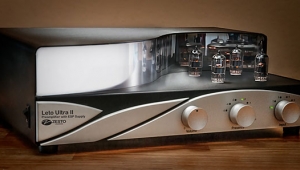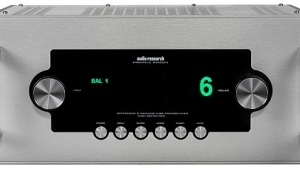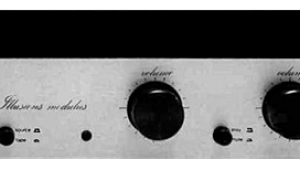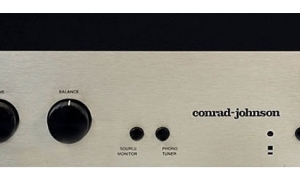| Columns Retired Columns & Blogs |
Zesto Audio Leto line preamplifier
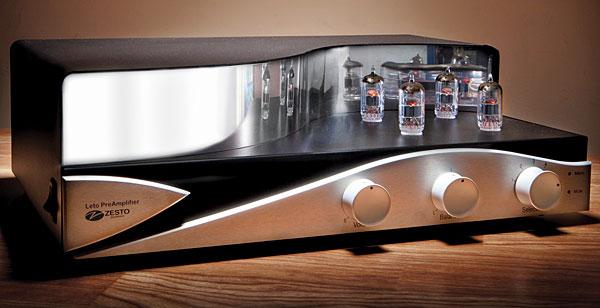
When Carolyn Counnas, co-founder of Zesto Audio, contacted editor John Atkinson to ask about getting the Leto, the company's tubed line stage preamplifier ($7500), reviewed in Stereophile, JA suggested that I do the job. I'd recently reviewed competing designs from Nagra and VTL (see reviews in April 2013 and June 2013, respectively) and I was thrilled—I always look forward to hearing a tube preamp from a company I'm unfamiliar with, and besides, I'd seen pictures of the drop-dead-gorgeous Leto. After nearly 30 years of reviewing all sizes and pedigrees of preamps, power amps, and integrateds, I'm weary of staring at nondescript rectangular boxes in various shades of silver and black.
The Leto's four tubes are mounted on an exposed black platform backed by an S-curved rear wall of mirror-finish stainless steel that reflects the tubes' golden glow. Below the platform is an anodized aluminum silver front panel with a curved top on which are three knobs, for volume, balance, and Input selection. At the left end of the front panel floats a small, rounded triangle of silver that displays the Zesto logo and the model name. Around the corner, discreetly tucked away on the left side panel, is the On/Off switch. The Leto stands on Isonode anti-vibration feet.
The Leto's sexy, curved, understated, almost feminine looks remind me of architect Eero Saarinen's 1962 design for the TWA Terminal at New York's JFK airport. Without exception, everyone who entered my listening room said, "That's gorgeous! What is it?"
But, of course, it's the sound that matters. When the Leto arrived, I itched to put it through its paces.
The Building of a Design
The Leto's beautiful countenance is the brainchild of Carolyn Counnas—her husband, co-founder George Counnas, takes care of Zesto's electronics side. I asked George to sum up his design philosophy for the Leto: "A preamp should be as neutral as possible and not add any components that could compromise the signal. For example, there are no transistors anywhere in the signal path. All the switching is done through reed relays."
The word that best describes the Leto's design is simplicity. The signal for each channel travels through one 12AX7 input tube, one 12AU7 driver tube, 1% metal-film resistors, and polypropylene capacitors. The Leto has three single-ended inputs and two true. balanced transformer-coupled inputs, as well as two single-ended outputs and two true transformer-coupled balanced outputs. Linked to one of the single-ended inputs is a pair of cinema-bypass outputs, to enable the Leto to be connected to a surround-sound processor. (The bypass function works without the Leto having to be turned on.) The remote control is the most minimalist I've ever encountered: it has four buttons, for Volume Up/Down, Mute, and Mono. As the Leto defaults to Mute when turned on, there's a remote bypass switch on the rear panel that enables the Mute function to be bypassed in the event the remote's batteries need replacing or the remote is lost. Finally, there are left and right ground-lift switches, which adjust the grounding of the single-ended outputs.
An internal switch enables the user to switch between 12 and 3dB of gain. The factory default setting is 12dB; the 3dB setting can be used if the normal operating volume falls below the volume dial's 10–12 o'clock range. I used the Leto with its gain set to 12dB. I used its single-ended inputs for my phono stage, CD player, and Blu-ray player, and its balanced outputs for my Audio Research Reference 75 power amp.
Sound Architecture
Some aspects of the Zesto Leto's sound reminded me very much of what I liked about the considerably more expensive Nagra Jazz line stage ($12,250), which I reviewed in April 2013. I would have liked to have directly compared the Leto and Jazz, but the Nagra had vacated my listening room nine months before; I had to rely on aural memory. One word that appeared many times in the notes I took while listening to the Leto also applies to my recollections of the Nagra's sound: delicacy. In the Bill Evans Trio's Sunday at the Village Vanguard (CD, JVC JVCXR-0051-2), drummer Paul Motian's subtle cymbal work was detailed but involving, and didn't distract from the others' playing. And throughout his piano's registers, Evans's piano sounded open, coherent, relaxed, and natural. As I mined my collection of jazz piano recordings, another word that popped up in my notes was liquidity. In the Tord Gustavsen Trio's Changing Places (CD, ECM 1834), the piano's airy, holographic image retained the warm flowing quality of a live performance, whether Gustavsen was playing subtly or during his more intense solos.
With well-recorded acoustic music, the Leto was also able to reproduce layers of room ambience. In the title track of David Chesky's Jazz in the New Harmonic (CD, Chesky JD358), the sound of Brooklyn's Hirsch Center, which engineer Nicholas Prout has perfectly captured, was reproduced in refined detail by the Leto—I felt transported to the hall. The retrieval of ambience went hand in hand with the Leto's ability to resolve detail, even in recordings of difficult, densely orchestrated works. During Knee 1, from Philip Glass's Einstein on the Beach, in the second recording of the work by Michael Riesman and the Philip Glass Ensemble (CD, Elektra Nonesuch 79323-2), the opening passage features churning woodwinds, electronic keyboards, and singers executing a series of rapid, dizzyingly difficult contrapuntal passages. Through the Zesto, not only was every passage reproduced cleanly and without blurring, but I could hear the air between the notes.
The Leto's flawless lower midrange made me want to listen to rich, breathy tenor saxophones, from George Coleman's work on Miles Davis's My Funny Valentine (CD, CK 93593 Columbia/Legacy), to John Coltrane's readings of standards on Stardust (CD, Prestige PRCD-30168). Regarding Coltrane's playing on this disc, my notes read "wide, deep, and round." Further up in the midrange, the Zesto's reproduction of women's voices was holographic and tactile; it unraveled individual phrasings, from Janis Ian's husky breathiness on Breaking Silence (CD, Morgan Creek/Analogue Productions CAPP-027) to Alison Krauss's ethereal, angelic vocalizing from her and Union Station's Live (CD, Rounder 11661-0515-2).
The Leto's pristine, uncolored, extended reproduction of the high frequencies also reminded me of the Nagra Jazz's similar qualities. The massed strings in Prokofiev's Romeo and Juliet, with Stanislaw Skrowaczewski conducting the Minneapolis Symphony (CD, Mercury Living Presence 432 004-2), can easily sound strident or blurred through lesser preamps. Not so with the Zesto—the violins didn't lose a jot of definition during the more heavily modulated passages, yet remained silky and airy. And in the more sparsely orchestrated sections of Stravinsky's Pétrouchka, with Antál Dorati conducting the same orchestra (CD, Mercury Living Presence 431 331-2), the biting, holographically imaged solo trumpets seemed to pop out of thin air toward the rear wall of a wide, deep stage.
Percussion and plucked strings were startlingly lifelike through the Leto. Listening to Tchaikovsky's The Nutcracker, with Dorati this time conducting the London Symphony (CD, Mercury Living Presence 432 751-2), I found myself focusing on the sparkling highs of the harp and triangle in the ballet's less densely orchestrated sections. And Daniel Druckmann's battery of percussion in George Crumb's Spanish Songbook 1: The Ghosts of Alhambra (CD, Bridge 9335) shimmered with perfect definition and extended upper harmonics in the recording space.
Woodwinds in jazz recordings also impressed me—I focused on the upper register of Daniel Carter's airy but metallic flute in "X-ray," from Matthew Shipp's Nu-Bop (CD, Thirsty Ear 57114.2). The preamp's superb definition of plucked strings extended to well-recorded solo jazz guitar, from Bill Frisell's warm, involving solo take on John McLaughlin's "Follow Your Heart," from Ghost Town (CD, Nonesuch 79583-2), to the sparkling, ringing upper harmonics of Derek Bailey's unorthodox guitar techniques on his Improvisation (CD, Ampersand Ampere 2).
- Log in or register to post comments







